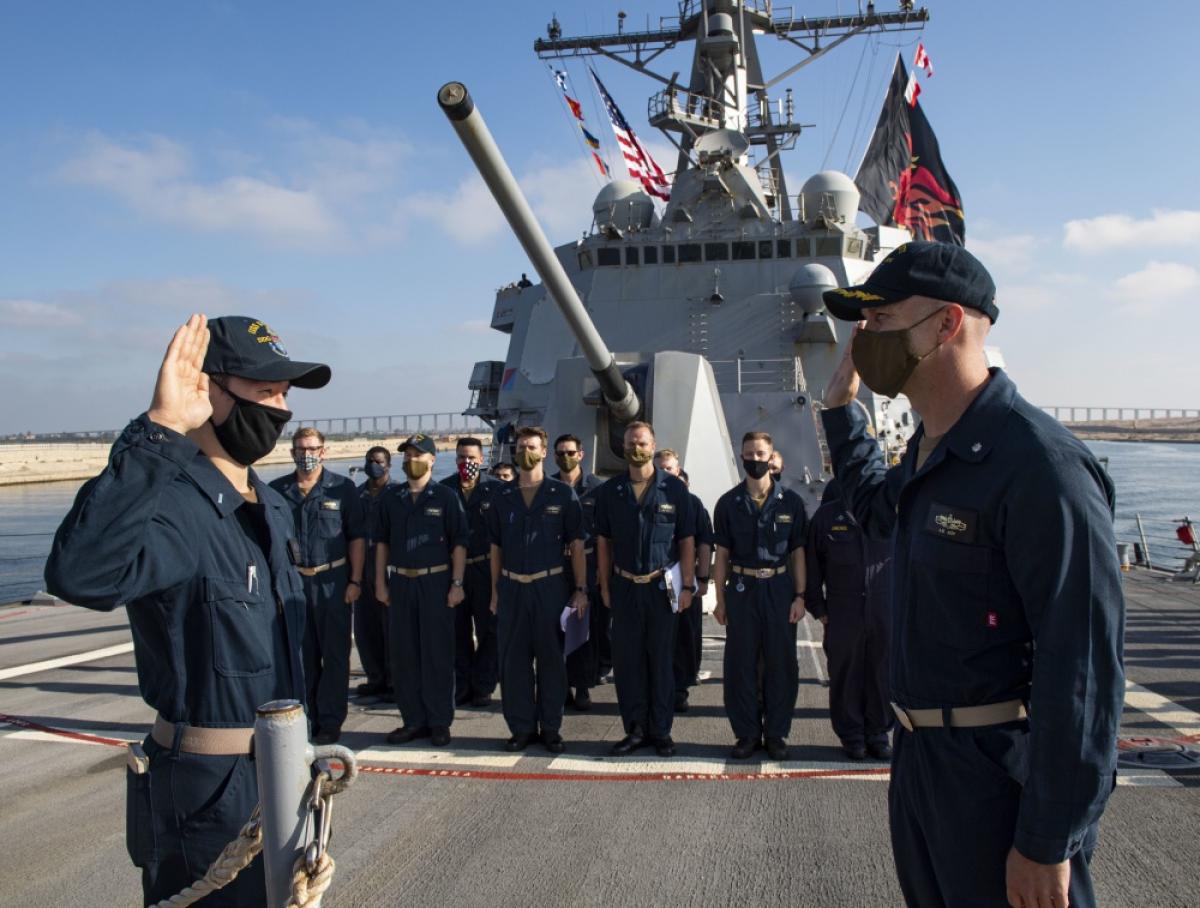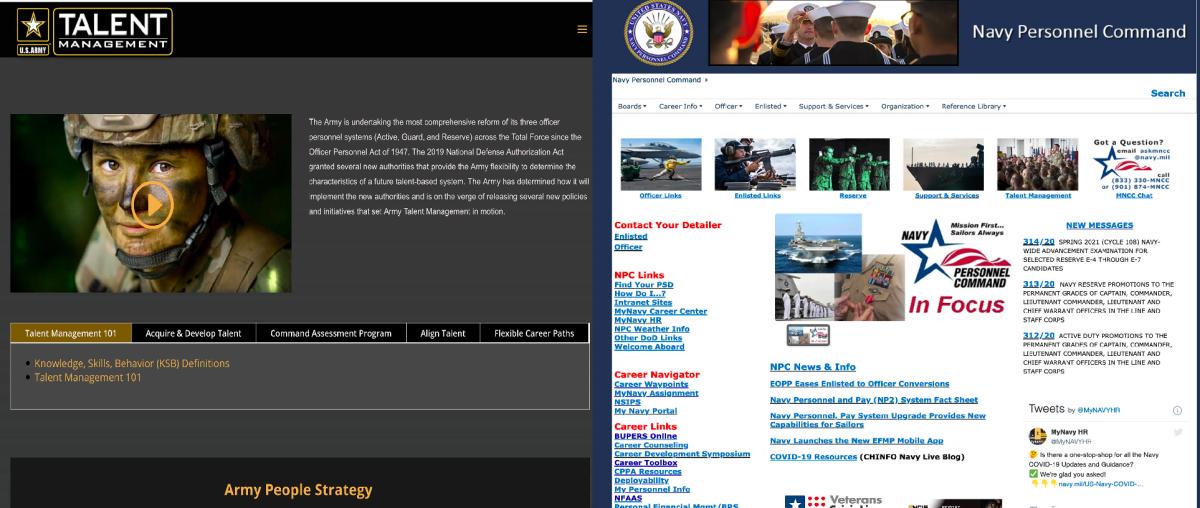The Navy has several programs and incentives for officer retention: the Career Intermission Program, Fleet Scholars Education Program, Targeted Reentry Program, and Low-Residency Graduate Education Program, to name a few. However, a web of disparate programs that tries to entice officers to stay is not a retention strategy.
Building on “Sailor 2025,” the Naval Personnel Command’s personnel management program for both officers and enlisted, and lessons learned from the Army’s Talent Management Task Force, we outline an attempt at streamlining, updating, and prioritizing the Navy’s officer talent management efforts into a compelling retention strategy. This strategy has three pillars: leadership development and selection, entrusted innovation, and detailing/assessment modernization, all of which must be promoted on a coherent and modern marketing platform that makes the strategy stick.
Leadership Development and Selection
In the opening statement of his confirmation hearing, now Secretary of the Navy Kenneth Braithwaite offered a scathing rebuke of the Navy’s “failure of leadership,” citing recent media headlines.1 Based on the research of Lieutenant Daniel Stefanus at the Office of the Chief of Naval Personnel, many junior officers would agree this is an issue. According to Stefanus’s 2019 survey, junior officers would choose to serve again under only 45 percent and 55 percent their previous department heads and commanding officers, respectively.2
Unit level leadership lays the foundation for retaining talent. The Army, for example, has determined that battalion command—equivalent to the first at-sea command tour—is the fulcrum around which the entire service turns. To ensure a more comprehensive selection process, it created the Battalion Commander’s Assessment Program (BCAP). The five-day program at Fort Knox seeks to expand on previous evaluations and rankings by sending candidates through a battery of tests, from physical to psychological. On graduation, battalion commander candidate rankings are reordered, taking course performance into consideration. This ensures that command selection of candidates with “good paper” is not preordained.3
The long-term effects of the BCAP on the leadership cadre of the Army are as yet undetermined, but it should raise the bar for this career milestone. Adopting such a program in the Navy has the potential to pay huge dividends in not only the short-term performance of commands, but also the long-term training, mentorship, and retention of junior officers.
Entrusted Innovation
Junior officers want to influence the future of the Navy they will lead. Building off the research of Lieutenant Stefanus, we believe the “Audacious Team” concept he proposes will create innovative opportunities for junior officers to make a difference.4
Audacious Teams are internal consulting teams staffed by members across various communities to research and advise on matters such as talent management. Members would be hand-selected by their respective communities, in coordination with the Bureau of Personnel, to serve following their first shore tour. Selection criteria would be based on individual expertise, demonstrated problem-solving acumen, and ability to work in cross-organizational teams. But instead of focusing solely on retention solutions—though that likely would be the first team—these groups could be given “wicked” problems (e.g., the 355-ship Navy, Air Wing of the Future, etc.). Rapid testing of hypotheses would be an integral part of the program.5
As an incentive to recruit the best and brightest from the fleet, the tour should be tied to a master’s degree earned concurrently with the assignment and paid for by the military—not through the graduate education voucher program or GI Bill but perhaps concurrent with Fleet Scholars Education or Low-Residency Graduate Education Programs. Fitness reports for these individuals must be signed by an admiral, and the billet must be briefed at boards as highly competitive versus “off-track.”
In addition to Audacious Teams, junior officers must be allowed wide autonomy to innovate at the deckplate level. The common perception among junior officers is that the Navy is burdened with bureaucratic processes, leaving many top performers frustrated with their inability to effect change. Leaders at all levels must allow junior officers to find creative ways to increase efficiency, safety, and mission accomplishment. In the current global market, agile and adaptive companies are best poised to survive. In the same way, the Navy must become an agile force led by creative thinkers who are allowed to test bold and unconventional ideas. Reinforcing critical thinking skills from Audacious Teams to the deckplate also would promote sound decision-making—a much needed aptitude—through collaboration with senior action officers and decision makers.6
Detailing/Assessment Modernization
The Navy should adopt the Jetstream platform, a detailing marketplace developed by the explosive ordnance disposal community similar to MyNavy Assign for enlisted personnel and the Army Talent Alignment Process. The Navy needs such a marketplace to enhance transparency and trust in the officer detailing process. Jetstream is ready to be implemented across the fleet—and should be without delay.7
The platform would be an information resource that expands the reach of the detailer and the situational awareness of the officer. Detailers could reduce their correspondence burden by having an interactive FAQ section, a place to publish community briefs and board results, and a platform to publicize success stories, not only in detailing, but also for their communities. Officers would have easy access to a record of all correspondence, could see how job selections historically affect board competitiveness, and could use a scheduling function to talk to/meet with the detailer. There could even be a LinkedIn-type function that connects an interested officer with the current billet holder to learn more about the position.
The Jetstream platform also could help reform the performance assessment system. For example, this single system could connect to and show results of all performance records: awards, fitness reports, self-assessments/resumes, 360 review data, etc. By having all performance indicators available, gaining commands would have a more complete picture of prospective candidates. For community briefs, there could be more nuance on the individual paths of command selectees versus the simple percentages of billets held by those selected, providing evidence of success beyond the “golden path” narrative. For example, in aviation, a career progression from production tour to department head to joint tour could be detailed per command selectee, instead of stating only that 75 percent of commanding officers selected participated in Tours with Industry.
Storytelling
Two screenshots (Figure 1)—one of the talent management portal of the Navy and the other of the Army—show the Navy’s lack of prioritization, effort, and evocative storytelling in the fight for officer talent.
On the Naval Personnel Command’s website, you will find the talent management page through a small hyperlink; a “Sailor 2025” pamphlet that has not been updated since 2017; and a smattering of other resources scattered across the site. In contrast, the Army’s talent management resources include a dedicated web portal, articles, podcasts, and videos from as recent as May 2020—a centralized hub from which to tell its story. Most important, the layout of the Army’s website conveys which programs are of primary importance to its talent management strategy: the BCAP, the new Colonel Command Assessment Program, and Army Talent Alignment Process. Two are focused on leadership selection and the other on the assignment process—all other efforts are subservient to these two priorities.
The Navy needs a dedicated officer talent retention website to more effectively project its retention strategy and primary lines of effort and, ultimately, tell a better story. This platform would complement Jetstream—which could be accessed from the site—as both a forum to showcase success outside the detailing relationship and a resource for gathering real-time feedback. If commanding officers wanted to discuss talent retention with their wardrooms, they would have a repository of programs and statistics, as well as testimonials on current and future policy from which to draw. Junior officers would have a place to give honest critiques of those options and strategies, not just for the commanding officer’s benefit, but also the entire Navy.
A Compelling Strategy
The Navy cannot afford to subject its retention success to market cycles. The above recommendations are all relatively low-cost endeavors for the current fiscal environment. Their complementary qualities have the potential to have a multiplying effect on retention in creating a compelling retention strategy.
1. Phil Stewart and Idress Ali, “U.S. Navy Suffering from ‘Failure in Leadership,’ Says Nominee to Lead It,” Reuters, 7 May 2020 www.reuters.com/article/us-usa-navy/u-s-navy-suffering-from-failure-in-leadership-says-nominee-to-lead-it-idUSKBN22J2AD.
2. LT Daniel Stefanus, USN, “Retaining More High-Performing Aviation, Sub, and SWO Talent,” MyNavy HR Feeder Board, 18 February 2020.
3. Army Talent Management Task Force, “Army Announces New Battalion Commander Selection Program,” 6 November 2019, www.army.mil/standto/archive_2019-12-06/.
4. LT Daniel Stefanus, USN, “Beyond Golden Handcuffs,” OPNAV N1 report, 29 April 2020.
5. Jon Kolko, “Wicked Problems: Problems Worth Solving,” Austin Center for Design, 6 March 2012, www.google.com/url?q=https://ssir.org/books/excerpts/entry/wicked_problems_problems_worth_solving%23:~:text%3DA%2520wicked%2520problem%2520is%2520a,these%2520problems%2520with%2520other%2520problems&sa=D&ust=1595215526461000&usg=AFQjCNEZzK109_qBx8LFj2MRmG1aDflGWA.
6. CAPT George Galdorisi, USN (Ret.), “Warfighting Demands Better Decisions,” U.S Naval Institute Proceedings 146, no. 6 (June 2020), and William Williamson III, “From Battleship to Chess,” U.S Naval Institute Proceedings 146, no. 7 (July 2020).
7. LT Nicholas Stoner and CDR Alex Campbell, USN, “The Navy Is Strangling Its Most Promising Talent Management Initiatives,” USNI Blog, 20 August 2019, https://blog.usni.org/posts/2019/08/20/the-navy-is-strangling-its-most-promising-talent-management-initiatives.




